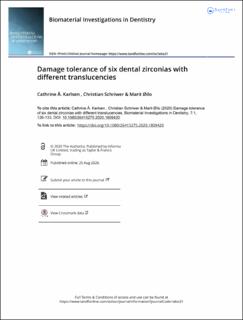| dc.contributor.author | Karlsen, Cathrine Å | |
| dc.contributor.author | Schriwer, Christian | |
| dc.contributor.author | Øilo, Marit | |
| dc.date.accessioned | 2021-02-16T11:33:14Z | |
| dc.date.available | 2021-02-16T11:33:14Z | |
| dc.date.created | 2020-11-16T14:11:08Z | |
| dc.date.issued | 2020 | |
| dc.Published | Biomaterial Investigations in Dentistry. 2020, 7 126-133. | |
| dc.identifier.uri | https://hdl.handle.net/11250/2728347 | |
| dc.description.abstract | Purpose: High-translucent dental zirconia has been introduced as a suitable material for anterior monolithic restorations. The material composition differs from traditional 3Y-TZP both with regard to yttria content and grain size. Little is known regarding how these alterations affect other properties than translucency and flexural strength. The aim of this study was to evaluate the crack propagation resistance and hardness of dental zirconias with different yttria content and different manufacturing methods. Materials and methods: Measurement of hardness (HV2/5) and crack propagation from the indents (damage tolerance) was performed using a hardness tester(Vicker) on a flat polished surface of five crowns from six different commercial dental zirconias; one hard-machined 3Y-TZP, three soft-machined 3-5% yttria-stabilized zirconias and two soft-machined zirconias with 5% yttria content. Results: Damage control varied greatly among dental zirconias with different compositions and fabrication methods. The hard-machined 3Y-TZP had better crack propagation resistance than soft-machined, 3-5% yttria-stabilized zirconias Conlcusion: The ultra-translucent zirconias with 5% yttria content had the lowest crack propagation resistance. Hardness is not a suitable indicator for damage tolerance. | en_US |
| dc.language.iso | eng | en_US |
| dc.publisher | Taylor & Francis | en_US |
| dc.relation.uri | https://www.tandfonline.com/doi/pdf/10.1080/26415275.2020.1809420 | |
| dc.rights | Navngivelse 4.0 Internasjonal | * |
| dc.rights.uri | http://creativecommons.org/licenses/by/4.0/deed.no | * |
| dc.title | Damage tolerance of six dental zirconias with different translucencies | en_US |
| dc.type | Journal article | en_US |
| dc.type | Peer reviewed | en_US |
| dc.description.version | publishedVersion | en_US |
| dc.rights.holder | Copyright 2020 The Author(s). | en_US |
| cristin.ispublished | true | |
| cristin.fulltext | original | |
| cristin.qualitycode | 1 | |
| dc.identifier.doi | 10.1080/26415275.2020.1809420 | |
| dc.identifier.cristin | 1848376 | |
| dc.source.journal | Biomaterial Investigations in Dentistry | en_US |
| dc.source.40 | 7 | |
| dc.source.pagenumber | 126-133 | en_US |
| dc.identifier.citation | Biomaterial Investigations in Dentistry. 2020, 7 (1), 126–133 | en_US |
| dc.source.volume | 7 | en_US |
| dc.source.issue | 1 | en_US |

